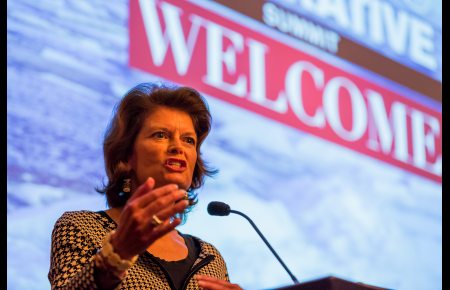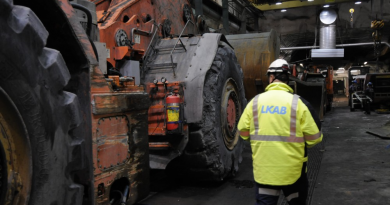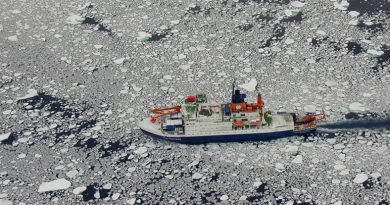Alaska sprints to build up Arctic infrastructure as development looms
 With Arctic riches beckoning as the ice cap crumbles, world and local leaders eyeing the risks and rewards of development in the fragile high north gathered under one roof this weekend for a conversation on possibilities that seem as vast as the region’s frigid ocean itself.
With Arctic riches beckoning as the ice cap crumbles, world and local leaders eyeing the risks and rewards of development in the fragile high north gathered under one roof this weekend for a conversation on possibilities that seem as vast as the region’s frigid ocean itself.
For generations, Alaskans have long pinned their hopes on the Arctic’s economic possibilities, where an undersea treasure of oil and gas that could rival some of the world’s largest fields may be just the tip of the iceberg. The nation, too, seems to be slowly awakening to prospects that range from massive mineral and methane deposits to ice-free sea routes that could slash shipping times between the wealthiest nations.
Yet where developers and financiers envision a land of plenty, conservationists and Alaska Native hunters fear the demise of the bowhead whales, walrus, polar bears and other icons of the Far North. Some say climate change already threatens the animals and the Alaska Native villages that feed on them. Throw in a disaster, such as a chemical discharge or oil spill, and their survival becomes more tenuous.
Therein lays the challenge for the Arctic Imperative Summit, which got into full swing Saturday at Anchorage’s Hotel Captain Cook. The big question: How do you develop the nation’s last frontier — even as you protect it?
Exploratory drilling
For most of the year, white nothingness still marks that wilderness hundreds of miles north of Anchorage, Alaska’s largest . But industrial activity is growing. Marine traffic through the 50-mile-wide chokepoint known as the Bering Strait has doubled in recent years to more than 400 ships, the U.S. Coast Guard has said.
This summer those ships include Royal Dutch Shell’s, some of which recently began steaming to the Arctic’s Beaufort and Chukchi seas in anticipation of launching the region’s first exploratory drilling in two decades. Oil giants ConocoPhillips and Statoil of Norway are waiting in the wings.
The increased traffic includes research ships, adventure tour cruises and icebreakers such as China’s new “Snow Dragon.” Federal cartographers are hurrying to plumb a seafloor that’s not been mapped in more than 200 years.
Yet with all this activity and more to come, Alaska’s Arctic still lacks a deepwater port to support oceangoing vessels. There’s limited communications equipment, few aircraft hangars and not many airstrips capable of accepting jets.
The lack of facilities was underscored this summer, when the Coast Guard committed to its first summertime presence in the Arctic. They brought up dozens of personnel and two helicopters to Barrow, the U.S. Arctic’s largest city with 4,400 residents. But because the nearest Coast Guard base is 900 miles to the south on Alaska’s Kodiak Island, the Coast Guard leased a hanger for those aircraft and bunked some 40 men and women in local hotels.
Where are the icebreakers?
Building up the Arctic was on the minds of those at the four-day conference Saturday.
Sen. Lisa Murkowski said the nation is shirking its duty in northern Alaska as other nations lay the groundwork to take advantage of the resources. She didn’t mention ratification of the Law of the Sea Treaty, a United Nations agreement signed by more than 160 countries but not the U.S. She plans to push for Senate approval this fall. Among other things, that could affirm the nation’s right to an offshore area the size of California that begins 200 miles off the northern coasts, she said.
Instead, she hammered away at the need for more U.S. icebreakers. Russia has 33 icebreakers. Canada has six, Murkowski told a packed audience. The U.S. has just one that’s working — the Healy that this winter helped the Russian icebreaker Renda muscle through sea ice to deliver much-needed fuel to Nome.
“Russia is moving forward. Canada is moving forward. Alaska can’t be forced to sit in the middle of this activity, bearing all of the same risk but potentially none of the reward as we see throughput through our pipeline going down, our jobs disappearing,” Murkowski said. “I want Alaska to be setting the standard.”
She’ll be fighting this fall to increase the nation’s paltry $8 million budget for new icebreakers, and to homeport one of the Coast Guard’s new national security cutters in Alaska at the Kodiak base, she said.
As for Sen. Mark Begich, he told the audience Friday night that next month he’ll introduce a bill to create an Arctic Deepwater Port Authority. It would be a public and private partnership that can plan, finance, build and operate a deepwater port and possibly smaller ports in northern Alaska. The port would be a full-service Arctic gas station as the offshore oil and gas industry grows in Alaska, providing refuge for Arctic shippers and a base for the Coast Guard, he said.
D.C. is finally tuning into the Arctic, thanks to headlines about Shell’s preparations and the Renda’s fuel delivery this winter. “It’s like they discovered an ocean,” he said.
New hangar in Barrow?
The state of Alaska is crafting plans, too. The Alaska Industrial Development and Export Authority, a state-run economic development corporation, is working with the Coast Guard, Barrow’s Alaska Native corporation, and others on a plan to build a hangar in Barrow. It would be owned by the state and could be leased to the U.S. Coast Guard or other federal agencies, said Ted Leonard, AIDEA’s executive director.
Neither the final design nor how many millions of dollars it will cost is known, he said. One idea includes building a facility large enough to house not only the U.S. Coast Guard but oil exploration companies and others doing work in the region, said Leonard.
The authority — recently given new latitude to support federal efforts to develop the north — is also involved in an effort that may lead to the U.S. Arctic’s first deepwater port, officials said.
AIDEA has signed a predevelopment agreement with a “resource developer” to assess the feasibility of building the port along the Chukchi Sea, said Hugh Short, chairman of AIDEA. He wouldn’t say exactly where or name the “resource developer.” More will be announced in the coming weeks, he promised.
Speakers kicking off the first full day Saturday repeatedly called for environmentally safe development. Among them was Fran Ulmer, chair of the U.S. Arctic Research Commission, who has fought for heightened drilling standards to prevent a spill in the Arctic.
As the other seven Arctic nations have done, the U.S. in 2009 developed an Arctic policy that spelled out the needs in the developing region, such as local input and strong environmental standards. But the U.S. is the only Arctic country without a strategic plan that commits resources to address gaps in science, infrastructure and other needs, Ulmer said.
“Other Arctic nations have taken this to another level,” she said. “They have put resource dollars behind their ideas. Other countries have stepped up and said we will make the investments that are necessary for research, for icebreakers, for ports. They have done things to put their money where their mouth is, in a way that, I’m embarrassed to say, we have not yet done as a nation.”
Contact Alex DeMarban at alex(at)alaskadispatch.com
For more stories at Alaska Dispatch, click here



